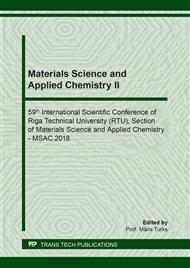[1]
C. Papadimitriou, G. Krey, N. Stamatis, A. Kallianiotis, The use of waste mussel shells for the adsorption of dyes and heavy metals, Journal of Chemical Technology and Biotechnology. 8 (2017) 1943-1947.
DOI: 10.1002/jctb.5247
Google Scholar
[2]
S. Hu, Y. Wang and H. Han, Utilization of waste freshwater mussel shell as an economic catalyst for biodiesel production, Biomass and Bioenergy. 8 (2011) 3627-3635.
DOI: 10.1016/j.biombioe.2011.05.009
Google Scholar
[3]
S. Pena-Rodríguez, D. Fernandez-Calvino, J.C. Novoa-Munoz, M. Arias-Estévez; A. Nunez-Delgado, M.J. Fernandez-Sanjurjo, E. Alvarez-Rodriguez, Kinetics of Hg(II) adsorption and desorption in calcined mussel shells, Journal of Hazardous Materials. 180 (2010) 622-627.
DOI: 10.1016/j.jhazmat.2010.04.079
Google Scholar
[4]
N. Seco-Reigosa, S. Pena-Rodríguez, J.C. Novoa-Munoz, M. Arias-Estevez, M.J. Fernandez-Sanjurjo, E. Alvarez-Rodríguez, A. Nunez-Delgado, Arsenic, chromium and mercury removal using mussel shell ash or a sludge/ashes waste mixture, Environmental Science and Pollution Research. 20 (2013) 2670-2678.
DOI: 10.1007/s11356-012-1192-6
Google Scholar
[5]
R. Paradelo, M. Conde-Cid, L. Cutillas- Barreiro, M. Arias-Estevez, J.C. Novoa-Munoz, E. Alvarez-Rodríguez, M.J. Fernandez-Sanjurjo, A. Nunez-Delgado, Phosphorus removal from wastewater using mussel shell: Investigation on retention mechanisms, Ecolgical Engineering. 97 (2016) 558-566.
DOI: 10.1016/j.ecoleng.2016.10.066
Google Scholar
[6]
M. El Haddad, Removal of Basic Fuchsin dye from water using mussel shell biomass waste as an adsorbent: Equilibrium, kinetics, and thermodynamics, Journal of Taibah University for Science. 5 (2015) 664-674.
DOI: 10.1016/j.jtusci.2015.08.007
Google Scholar
[7]
M. El Haddad, A. Regti, R. Laamari, R. Slimani, R. Mamouni, S. El Antri, S. Lazar, Calcined mussel shells as a new and eco-friendly biosorbent to remove textile dyes from aqueous solutions, Journal of the Taiwan Institute of Chemical Engineers. 45 (2014) 533-540.
DOI: 10.1016/j.jtice.2013.05.002
Google Scholar
[8]
M. El Haddad, A. Regti, R. Slimani and S. Lazar, Assessment of the biosorption kinetic and thermodynamic for the removal of safranin dye from aqueous solutions using calcined mussel shells, Journal of Industrial and Engineering Chemestry. 20 (2014) 717-724.
DOI: 10.1016/j.jiec.2013.05.038
Google Scholar
[9]
J.H. Shariffuddin, M.I. Jones and D.A. Patterson, Greener photocatalysts: Hydroxyapatite derived from waste mussel shells for the photocatalytic degradation of a model azo dye wastewater, Chemical Engineering Research and Design. 91 (2013) 1693-1704.
DOI: 10.1016/j.cherd.2013.04.018
Google Scholar
[10]
D.R. Merouani, F. Abdelmalek, F. Taleb, M. Martel, A. Semmoud and A. Addou, Plasma treatment by gliding arc discharge of dyes/dye mixtures in the presence of inorganic salts, Arabian Journal of Chemestry. 8 (2015) 155-163.
DOI: 10.1016/j.arabjc.2011.01.034
Google Scholar
[11]
D.R. Merouani, F. Abdelmalek, M.R. Ghezzar, A. Semmoud, A. Addou and J.L. Brisset, Influence of peroxynitrite in gliding arc discharge treatment of alizarin red s and postdischarge effects, Industrial and Engineering Chemestry Research. 52 (2013) 1471-1480.
DOI: 10.1021/ie302964a
Google Scholar
[12]
A. Iddou and M.S. Ouali, Waste-activated sludge (WAS) as Cr(III) sorbent biosolid from wastewater effluent, Colloids Surfaces B Biointerfaces. 66 (2008) 240-245.
DOI: 10.1016/j.colsurfb.2008.06.018
Google Scholar
[13]
A. Iddou and S. Ouali, Étude de l'élimination de Cr(VI) par une boue biologique après épandage, Study of the elimination of Cr(VI) using an activated sludge after application, Water Quality. Research. Journal. 40 (2005) 184-190.
DOI: 10.2166/wqrj.2005.021
Google Scholar
[14]
H. Benchekor, A. Iddou, H. Hentit, A. Aziz and J.S. Piccin, Multilayer adsorption of purple NR5 industrial dye by Aristeus antennautus shell in aqueous solution, Key Eng. Mater. 762 (2018) 109-114.
DOI: 10.4028/www.scientific.net/kem.762.109
Google Scholar
[15]
H. Aguedal, H. Hentit, D.R. Merouani, A. Iddou, A. Shishkin and J.C. Jumas, Improvement of the sorption characteristics of diatomite by heat treatment, Key Eng. Mater. 721 (2016) 111-116.
DOI: 10.4028/www.scientific.net/kem.721.111
Google Scholar
[16]
H. Khodja, A. Iddou, H. Aguedal, A. Aziz and A. Shishkin, Bioremoval of lead (II) and cadmium (II) in single and multicomponent systems using penicillium sp., Key Eng. Mater. 762 (2018) 93-98.
DOI: 10.4028/www.scientific.net/kem.762.93
Google Scholar


